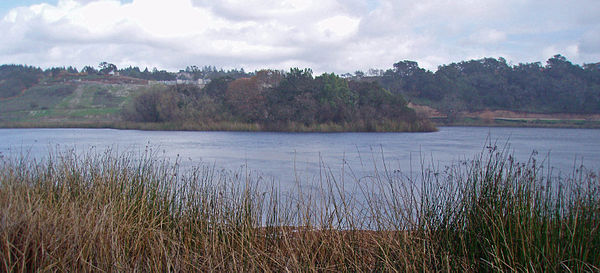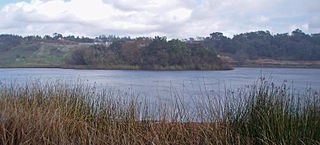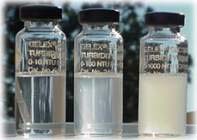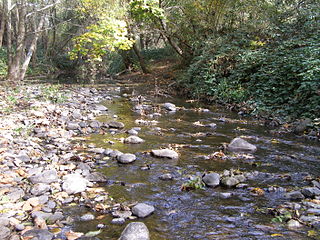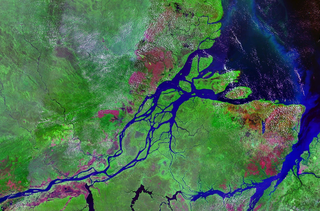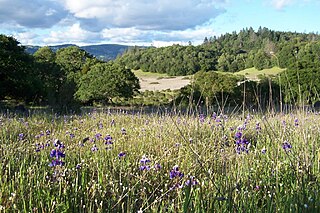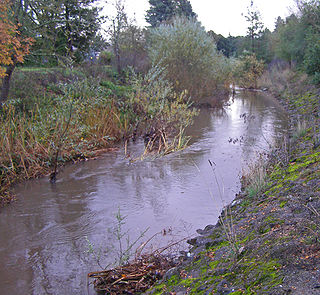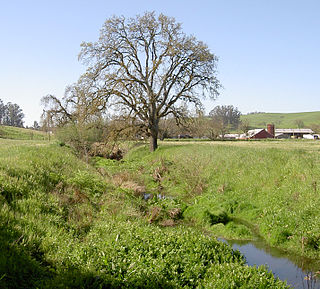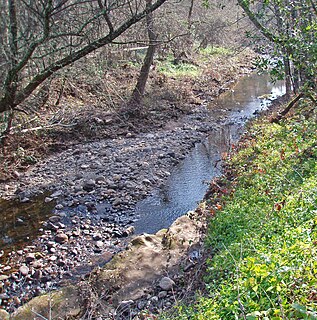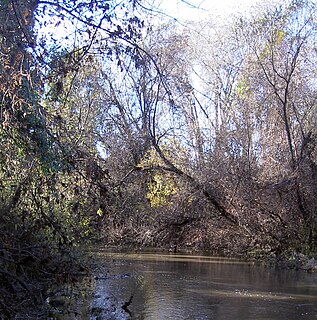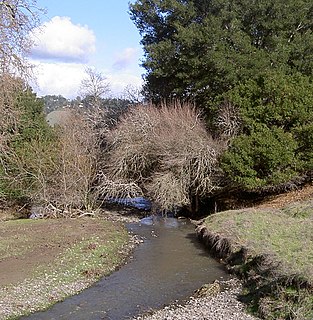| Piner Creek | |
|---|---|
 Piner Creek immediately above the confluence with Santa Rosa Creek | |
| Location | |
| Country | United States |
| State | California |
| Region | Sonoma County |
| City | Santa Rosa, California |
| Physical characteristics | |
| Source | Fountaingrove Lake |
| - location | Santa Rosa, California |
| - coordinates | 38°29′12″N122°43′10″W / 38.48667°N 122.71944°W [1] |
| - elevation | 495 ft (151 m) [1] |
| Mouth | Santa Rosa Creek |
- location | west of Santa Rosa, California |
- coordinates | 38°26′43″N122°46′35″W / 38.44528°N 122.77639°W Coordinates: 38°26′43″N122°46′35″W / 38.44528°N 122.77639°W |
| Basin size | 6.3 sq mi (16 km2) |
Piner Creek is a stream in northeast Santa Rosa, California, United States ( 38°27′40″N122°45′05″W / 38.46111°N 122.75139°W ) which originates as an outlet of Fountaingrove Lake. Piner Creek discharges to Santa Rosa Creek which in turn joins the Laguna de Santa Rosa. [2] The upper reaches in the foothills of the Mayacamas Mountains are at elevations of 200 to 300 feet (60 to 90 meters), while the lower and middle reaches are located on the Santa Rosa Plain at elevations of between the 110- and 140-foot (33- and 43-meter) contours; [3] therefore, these lower reaches have a gradient of about 1:250 toward the southwest. Geologic studies in the lower and middle reaches of Piner Creek indicate groundwater levels ranging from three to 15 feet (one to 5 meters) below the surface. [4] Prior to extensive urban development of the middle and lower reaches, the landscape earlier bore extensive agricultural uses including plum orchards, which fruit was subsequently processed for prunes.

A stream is a body of water with surface water flowing within the bed and banks of a channel. The stream encompasses surface and groundwater fluxes that respond to geological, geomorphological, hydrological and biotic controls.

Santa Rosa is a city in and the county seat of Sonoma County, in California's Wine Country. Its estimated 2016 population was 175,155. Santa Rosa is the largest city in California's Redwood Empire, Wine Country and the North Bay; the fifth most populous city in the San Francisco Bay Area after San Jose, San Francisco, Oakland, and Fremont; and the 28th most populous city in California.

California is a state in the Pacific Region of the United States. With 39.6 million residents, California is the most populous U.S. state and the third-largest by area. The state capital is Sacramento. The Greater Los Angeles Area and the San Francisco Bay Area are the nation's second- and fifth-most populous urban regions, with 18.7 million and 9.7 million residents respectively. Los Angeles is California's most populous city, and the country's second-most populous, after New York City. California also has the nation's most populous county, Los Angeles County, and its largest county by area, San Bernardino County. The City and County of San Francisco is both the country's second-most densely populated major city after New York City and the fifth-most densely populated county, behind only four of the five New York City boroughs.
Contents
The Piner Creek watershed consists of 4,048 acres (16.4 km2), approximately three-fourths of which lies within the municipal boundaries of the city of Santa Rosa. [5] About one-third of the watershed is developed as residential use, and about one-sixth of the land is open space or used for recreation or agriculture. One of the early surviving architectural features of Sonoma County is within the Piner Creek catchment basin: A well preserved Round Barn, constructed in 1899, a testament to the 19th century pasturage uses within this watershed. [6]

A drainage basin is any area of land where precipitation collects and drains off into a common outlet, such as into a river, bay, or other body of water. The drainage basin includes all the surface water from rain runoff, snowmelt, and nearby streams that run downslope towards the shared outlet, as well as the groundwater underneath the earth's surface. Drainage basins connect into other drainage basins at lower elevations in a hierarchical pattern, with smaller sub-drainage basins, which in turn drain into another common outlet.

Pasture is a concrete spatial area where farmers keep livestock for grazing.

